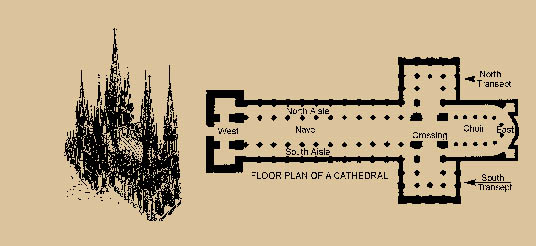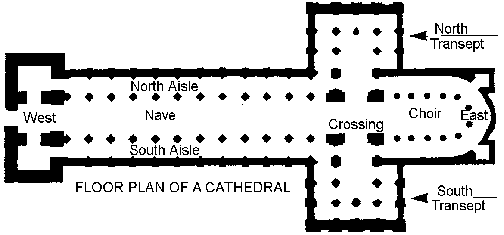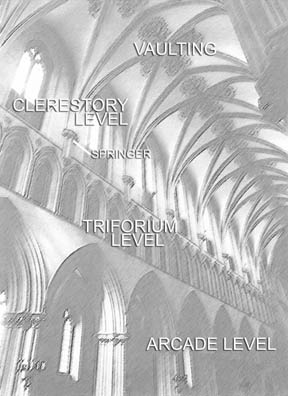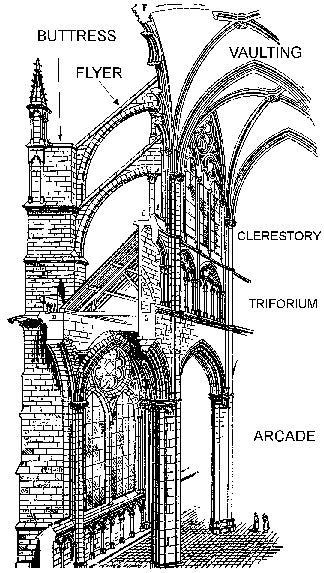
Masonic Education Series
How to Build a Gothic Cathedral
The Grand Lodge of England had it origin in the year 1717, and it is from that Grand Lodge and from that year that the modern system of Freemasonry traces its history. We know a lot about Masonic history since that time, but what was the status of Masons and Masonry in the years prior to the year 1717. What was happening just before the Grand Lodge of England was formed? At that time there existed wonders of architecture that were already centuries old. It was a time when there were no motors, no heavy machinery, and yet there stood structures that were masterworks of art and engineering. There were the intricate public buildings, the palaces, and the castles, but the most awe-inspiring examples were the towering gothic cathedrals. Men of means and of leisure, men of the aristocratic classes, became fascinated with these beautiful structures and set about trying to learn the secrets of their construction. In pursuit of these secrets they alarmed the doors of the operative lodges and in some cases they were accepted into the operative lodges as honorary members. As they immersed themselves in the work of the lodges, there grew another fascination: a fascination with the builders and with the fraternal code that bound them together. This presentation is about the Cathedral Builders: those dedicated men who served as inspiration for America's longest surviving fraternity. It is about who they were and about what they did. It is about that spark that brought our Order into existence. It is about the master builders and about how they erected those magnificent monuments to God.
In introducing you to the craft of these operative Masons, I would like for you to bring to mind a lowly peasant who might have lived nine hundred years ago. His home is a timber hut that is small, overcrowded, and has barely enough room to move about. It is dimly lit; the walls are unadorned and unsightly. The squalid conditions matter little to the peasant because he comes here mainly to eat and sleep: most of his waking hours are consumed in toil. Now, envision this lowly peasant as he passes through the massive doors of a Gothic cathedral. He stands at the "western end looking down that whole interior to the eastern end," and he is "overwhelmed by the sheer size, height and complexity" of what is laid out before him. He is awe-stricken. It was the original aim of the builders to impose just such a feeling on anyone who entered. The visitor looks upon what towers above him and it seems to stretch nearly to the heavens; he looks in front of him and it seems to go on nearly to the end of the earth. And it has an effect. He is impressed with the wealth and prominence of the church and there is little doubt in the peasant's mind about the power and majesty of God. It is this same awe that influenced the earlier speculative Masons, who asked themselves, "How is it possible to erect structures of such splendor with human hands; without the tools of the industrial age?"

If we are to build a cathedral of our own, faithful to those built by our ancient brothers, we need to begin with an acceptable floor plan, which is typically in the shape of a Latin cross. No two floor plans were exactly alike, but there was a general plan that all cathedral builders followed. For example, the long axis of all cathedrals lies on an east-west line. I know of no medieval cathedral that deviates from this design. The sacred chambers of the cathedral, the end occupied by the clergy, are always located on the east end, without exception. The west end, called the nave, housed the laity. Running the length of the cathedral are the isles, which are delineated by the outside walls and the piers of the nave. Each cathedral has transepts that extend north and south at the juncture of the nave and the choir; these transepts give the floor plan the appearance of the Latin cross, a shape that is said to represent Christ: the doorway on the west end is said to represent his pierced feet, the nave his body, the transepts his open arms, and the choir or altar end, his head.
 On the interior of the nave, we find three vertical levels: the lower level is called the arcade, which is dominated by towering piers. Above the arcade is a series of smaller piers that form the triforium. The triforium features a passageway that gives workers access to repair the roof of the isle and to work on the upper levels of the arcade. The highest level is called the clerestory. The clerestory provides light by way of its decorative windows.
On the interior of the nave, we find three vertical levels: the lower level is called the arcade, which is dominated by towering piers. Above the arcade is a series of smaller piers that form the triforium. The triforium features a passageway that gives workers access to repair the roof of the isle and to work on the upper levels of the arcade. The highest level is called the clerestory. The clerestory provides light by way of its decorative windows.
Only one material was considered suitable for the great cathedrals, and that was stone. But stone adds to the complexity of the project because there are inherent problems in building with stone—one of which is the difficulty in moving the heavy slabs. The Egyptians raised buildings in stone; they did it using massive stone slabs across massive columns or pillars to support the clerestory and roofs of their temples. This style was used by the Greeks as well. The Romans demonstrated that you can raise a stone structure without these massive slabs. The secret is to use arches of stone for windows and for doorways and to use stone vaults for ceilings. One of the problems you encounter with such a design is that stone vaults and arches are very difficult to build over the height and width of the space used in a cathedral. A vaulted ceiling is fairly easy to build if the enclosure is an arm's reach in any direction. But when the nave gets wider and the ceiling gets higher, the level of complexity increases quickly. The Norman or Romanesque style relied on rounded vaults supported by massive columns and thick walls. And they could only support small openings for light. These early Norman structures were simple in design and were solidly built, but they leave the visitor with a feeling of heaviness. And one of the problems with these rounded vaults is that when any stone is removed, the entire structure can collapse.
The Gothic style abandons the round arches and makes use of pointed arches which was made possible by one of the most importance advancements in architecture, ribbed vaulting. Why was ribbed vaulting so special? Well, the great weakness of early vaults was that they were not self-supporting. Take away some of the stones, and the vault falls down. A ribbed vault is self-supporting. If we take away all the stonework that lies between the ribs, the vault will still stand up on its own. This is a fundamental principle and is the whole basis of Gothic architecture. Only the ribs are of importance in holding the structure up.
The Gothic style abandons the round arches and makes use of pointed arches which was made possible by one of the most importance advancements in architecture, ribbed vaulting
Now that we have leap-frogged across several centuries of architecture, let's look at some of the problems the master builders had. Stone vaults are constructed in sections using stones that are carved in the workshops and fitted on the ground before they are hoisted to the ceiling. Each stone that makes up the four cross ribs in a vault is called a voussoir, a French word meaning wedge-shaped. Where the last voussoirs meet at the top of the vault we have one stone with four faces waiting to receive the thrust of the four ribs. This is called a boss or a keystone. When making a vault, the masons first build the required shape in wood, called a former, and place it in the desired position. Each voussoir is then laid on the former until the last voussoir reaches the top. The boss is then placed in position directly in the center, marrying the four faces of each of the top voussoirs and closing the vault. After three Hail Marys, the wood former is taken away and the four ribs stay up all on their own. The spaces between these ribs are filled with as light a stone as possible, and then covered with lime plaster.
 There were a few problems brought about by the new ribbed vaults. First, at the point where the vault begins on the capital there is a small capital stone on which the first voussoir sits. This first stone is known as a 'springer'. Originally the springers of several adjacent vaults competed for a place on one capital. Unless each springer was accurately positioned, it made for a weak point in the structure. Later, it was realized that the capital and the lowest voussoirs could be carved out of one stone, thus eliminating this major weakness in design. In time, several of the complex stones were employed, one above the other. Finally the voussoirs would disengage and radiate to their respective ribs.
There were a few problems brought about by the new ribbed vaults. First, at the point where the vault begins on the capital there is a small capital stone on which the first voussoir sits. This first stone is known as a 'springer'. Originally the springers of several adjacent vaults competed for a place on one capital. Unless each springer was accurately positioned, it made for a weak point in the structure. Later, it was realized that the capital and the lowest voussoirs could be carved out of one stone, thus eliminating this major weakness in design. In time, several of the complex stones were employed, one above the other. Finally the voussoirs would disengage and radiate to their respective ribs.
The next revolution in medieval construction was the flying buttress, or the flyer. It was invented to solve another problem brought about by ribbed vaulting. The problem was lateral thrust or a sideways push. This thrust begins at the keystone and propagates down the ribs to the springer so that there is both a downward push and an outward push. At the springer where the vaulting ribs sat at the triforium or clerestory level the outward force was tremendous, pushing outwards against the walls, and there was nothing on the opposite side to counterbalance this push. Our ancient brothers discovered this force because it caused clerestory walls to crack and the vaults to fall down, often crushing the workers below. [Our ancient brothers discovered this force because it caused clerestory walls to crack and the vaults to fall down, often crushing the workers below] This disaster resulted in many deaths and occurred with frightful regularity after ribbed vaulting became popular. Ribbed vaulting allowed for narrower ribs, lighter vaults, and small columns, and these improvements suggested that higher walls and more splendid stonework could be attempted. So as the structure reached for the sky, the triforium and clerestory levels became weak points.
The solution was the flying buttress. Buttresses were already being used on the outside walls, this was not a new idea, but they did not reach the clerestory level and did not provide adequate support at the clerestory wall where the thrust from the vault was greatest. This is were the flyers came in, giving support exactly where it was needed. These flyers transferred the stress created by the vault so that it radiated down to the buttresses.
Our ancient brothers discovered this force because it caused clerestory walls to crack and the vaults to fall down, often crushing the workers below
One more thing to notice about this system of flying buttresses is the pinnacle that sits on top of the upright part of the buttress. They are often pretty, some being objects of art in their own right, but they have been put there for structurally specific purpose, one that is essential to the role of the buttress, that is to act as a counterbalance for the residual outward thrust that is at work at this point. The height of the pinnacles above the flyer and the upright had to be carefully calculated to act as a counterforce.
With the lateral thrust now being transferred through this web of supports it meant that the walls of the nave and the vault could become higher still. And each guild wanted its cathedral to be taller and more splendid that any ever built. So each new cathedral pushed the limits of technology.
The beauty is that the structural support is outside the building and out of view; the visitor inside the nave gets a sense of lightness and airiness. The walls had numerous windows and doors and the columns and piers were so narrow with respect to their height that nothing in view from within the nave seems capable technically of supporting the whole structure. [The walls had numerous windows and doors and the columns and piers were so narrow with respect to their height that nothing in view from within the nave seems capable technically of supporting the whole structure.] Some call it Invisible Support--the impression of a weightless wall soaring above the nave. One wonders why the columns don't tilt over. Why don't the walls collapse, considering the number and extent of the perforations? And this was one of the cardinal principles of constructing Gothic walls--to hide, at least in the interior, the technical means for support.
So these are the major technical problems to be solved in building a cathedral that reaches for the sky. Now, let's consider the workers themselves. It is important to understand that there were several craft guilds involved in building a cathedral. There were mortar makers, carpenters, blacksmiths, roofers, and glassmakers, among others. The role of the mortar makers and glassmakers is obvious. Carpenters built the forms used to support the vaults and arches as they rose, they built the scaffolds, and they built the supports for the lead-sheeted roof. Blacksmiths made nails, tools, hinges, and various ornaments. But the greater volume of workers were workers in stone—the quarrymen, the master stone cutters, and the master sculptors. And the chief administrator, the person in charge of it all, was a stone mason whose title was Master Mason.
The master mason was the architect, he was the quality surveyor, he was the civil engineer, and he was the artist, all rolled into one. He designed the overall plan and he designed the details; he chose the quarry from which the stones would be mined, he chose the lime that would be used in the mortar, and he chose all the other materials to be used in the construction; he calculated the stresses and strains that would occur, and then he supervised the whole building project from the foundation to the top of the tower, and he stayed on until the project was either completed or was abandoned because of lack of money, or until his death. Because of financial problems, structural problems, or both, the completion of some of these cathedrals was delayed for as long as two hundred years, in which case, several Master Masons would have been in charge of a single project.
So it is the work of the stone mason that is most visible in a cathedral and it is the work of the stone mason that attracted men of wealth and leisure to study the secrets of cathedral architecture. These amazing structures created a growing interest of amateurs in architecture and in antiquity.
In the early history of Masonry, the order attracted many architects. Although the order has advanced in many ways, these early Masons would not have approved of what the Order has become today from admitting men so totally unskilled in architecture (and I point this out not as a criticism by to show how attitudes change.) Consider the following quote from A Pocket Companion for Freemasons, which says, "No man ought to attain to any dignity in Masonry who has not, at least, a competent knowledge in geometry and architecture; and if the sciences were more followed in the Lodges, what is unhappily substituted in their place would not prevail as it does." The reproving phrase suggests that many of the newcomers had joined simply because the lodge was a good club.
So our order was once devoted to architecture and the corollary science of geometry, topics that are still part of the modern ritual but have become incidental in modern Masonic practice. Perhaps we speculative Masons have not transmitted the secrets of our operative brethren as unimpaired as we boldly suggest in the second degree. What is worse, one writer believes our society has lost entirely the capacity to reconstruct these beautiful stone structures, and I quote:
Today we admire Gothic cathedrals, and yet, with our twentieth-century mentality, we lack any true basis for comprehending them. Even when they are preserved in a material sense, their spiritual significance seems completely hidden. Moreover, we have no real understanding of the standards which make them works of art, for we are not "cathedral minded" any more. That is easy to see, because we can no longer build Gothic cathedrals, even when we wish to do so. Nineteenth-century church architecture tried, and failed lamentably.
Cathedrals built today are nothing more than concrete and steel sky scrapers. They do not compare to the structures raised by the stone masons of Medieval Europe. From what we have discussed here, I hope the reader has gained an appreciation for the complexities involved in raising the magnificent cathedrals of Europe—the most glorious of which were built before the year 1650
References:
Thomas Maude, Guided by a Stone Mason: The Cathedrals, Abbeys and Churches of Britain Unveiled, I.B. Tauris Publishers, New York, 1997.
MacKenzie, Norman, Ed., Secret Societies, Crescent books, Inc., New York, 1967
Reference C: Jantzen, Hans, High Gothic: the Classic Cathedrals of Chartres, Reims, and Amiens, Princeton University Press, NJ, 1957.
Clifton-Taylor, Alec, The Cathedrals of England, Thames and Hudson, New York, 1967.
Oggins, Robin S., Cathedrals, MetroBooks, New York, 1996.
Macaulay, David, Cathedral: the Story of Its Construction, Houghton Mifflin Co, Boston, 1973.
...we are not "cathedral minded" any more. That is easy to see, because we can no longer build Gothic cathedrals, even when we wish to do so.